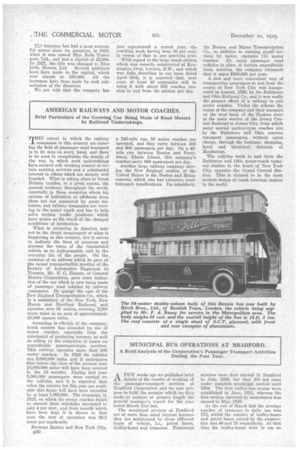AMERICAN RAILWAYS AND MOTOR COACHES.
Page 66

If you've noticed an error in this article please click here to report it so we can fix it.
Brief Particulars of the Growing Use Being Made of Road Motors by Railroad Undertakings.
THE extent to which the railway companies in this country are entering the field of passenger road transport is to be seen on every hand, and there is no need to recapitulate the details of the way in which such undertakings have secured sole working control of certain existing services and a substantial interest in others which are already well founded. What is taking place in Great Britain typifies, to a great extent, the general tendency throughout the world, especially in those countries where big centres of habitation or offshoots from them are not separated by great distances, and railway companies are turning to the motor coach and bus to help solve certain traffic problems which have arisen as the result of the changed conditions of locomotion.
What is occurring in America may llot be the direct counterpart of what is happening in this country, but it serves to indicate the lines of progress and stresses the value of the commercial vehicle as an indispensable unit in the everyday life of the people. On the _ occasion of an address which he gave at the recent transportation meeting of the ociety of Automotive Engineers in Toronto, Mr. F. C. Horner, of General Motors Corporation, gave some indication of the use which is now being made of passenger road vehicles by railway companies. He quoted the case of the New England Transportation Co., which is a subsidiary of the New York, New Haven and Hartford Railroad, and operates over 61 routes, covering 2,200 route miles in an area of approximately 30,000 square miles.
According to officials of the company, much success has attended its use of motor coaches, especially from . the standpoint of producing revenue, as well as aiding in the reduction of losses on unprofitable passenger-train services. This railway operates more than 000 motor coaches. In 1928 its vehicles ran 9,000,000 miles and it anticipates that before the close of the present year 1,000,000 miles will have been covered in the 12. months. During last year 5,500,000 passengers were carried on the vehicles, and it is expected that when the returns for this year are available this figure will have been exceeded by at least 1,000,000. The occasions, in 1928, on which the motor coaches failed to observe their schedules amounted to only 4 per cent., and from records which have been kept it is shown in that year the cost of operation was 29.3 cents per coach-mile.
Between Boston and New York City, B30
a 240-mile run, 50 motor coaches are operated, and they carry between 500 and 600 passengers per day. On a 40mile run between Boston and Providence, Rhode Island, this company's coaches carry 900 passengers per day.
Another large railway company serving the New England section of the United States is the Boston and Maine concern, which also has extensive roadtransport ramifications. Its subsidiary,
























































































































